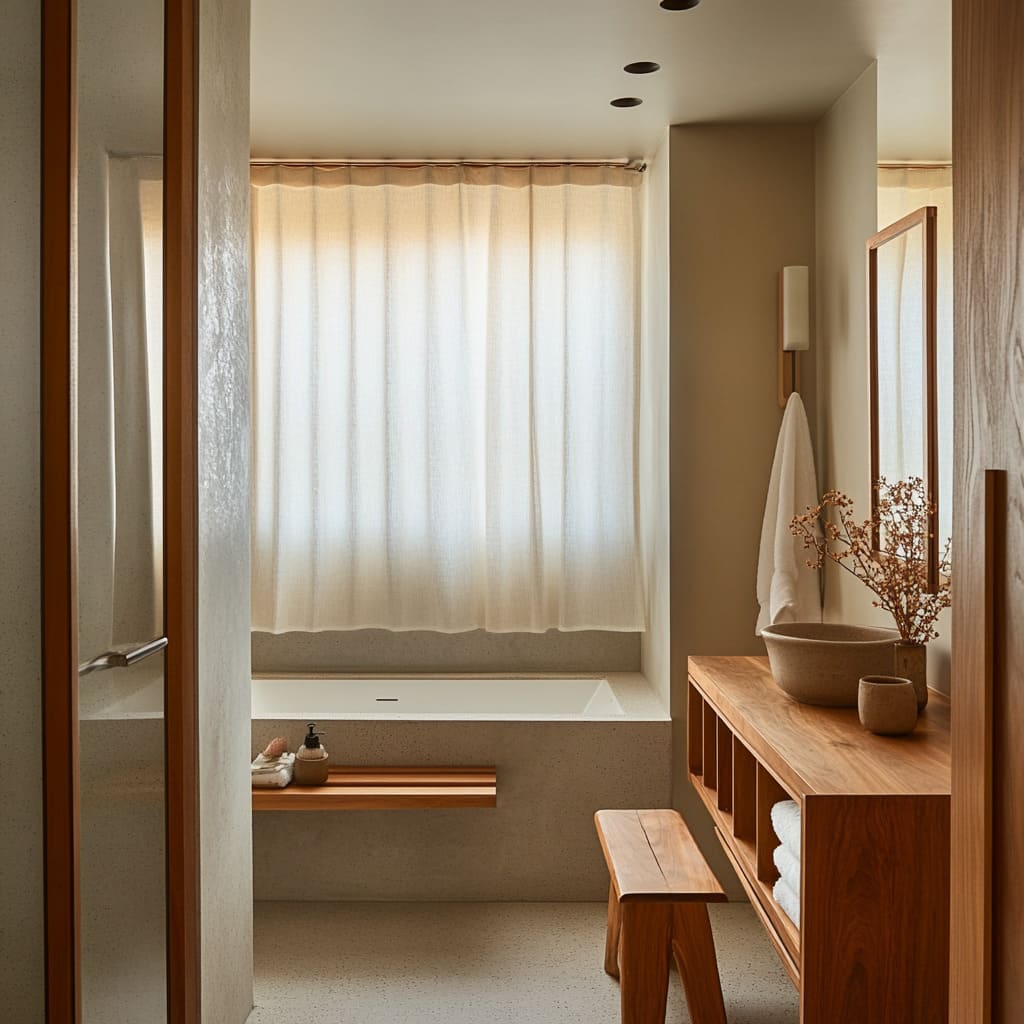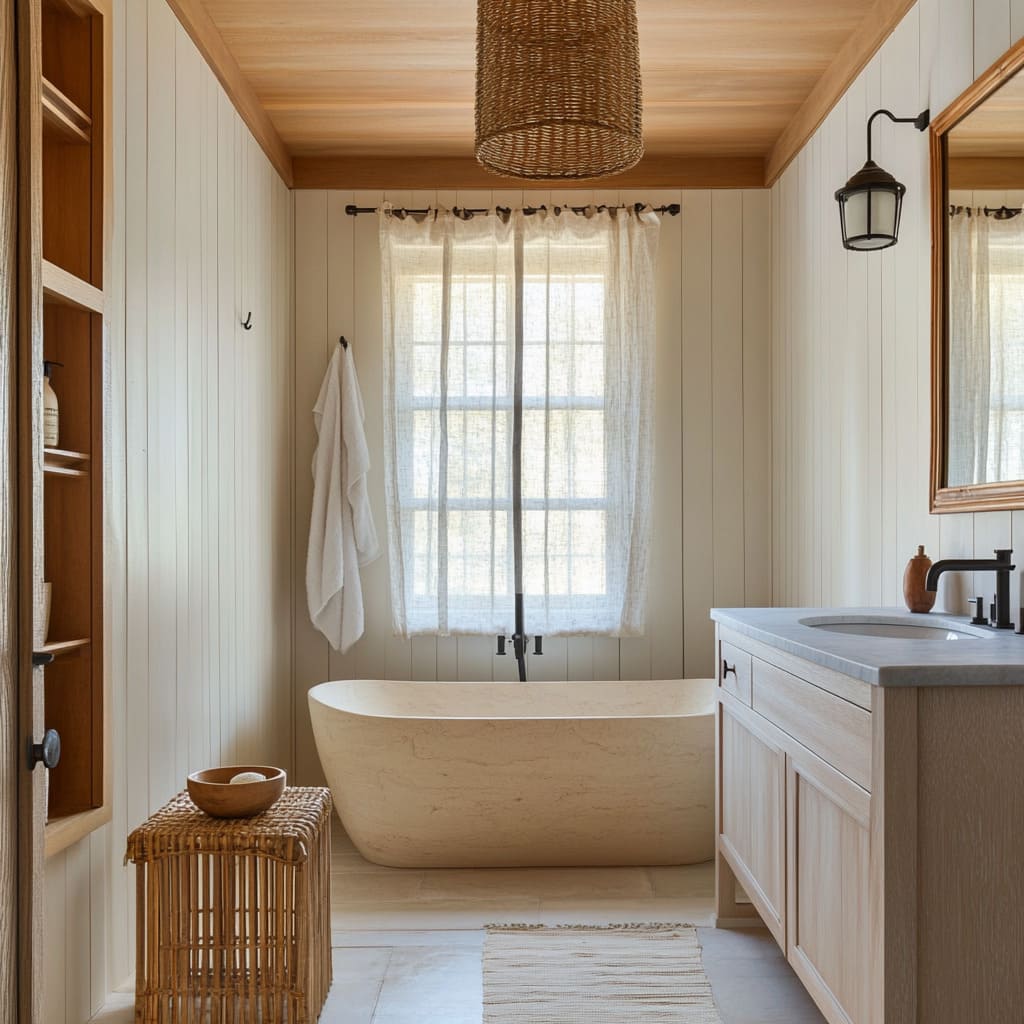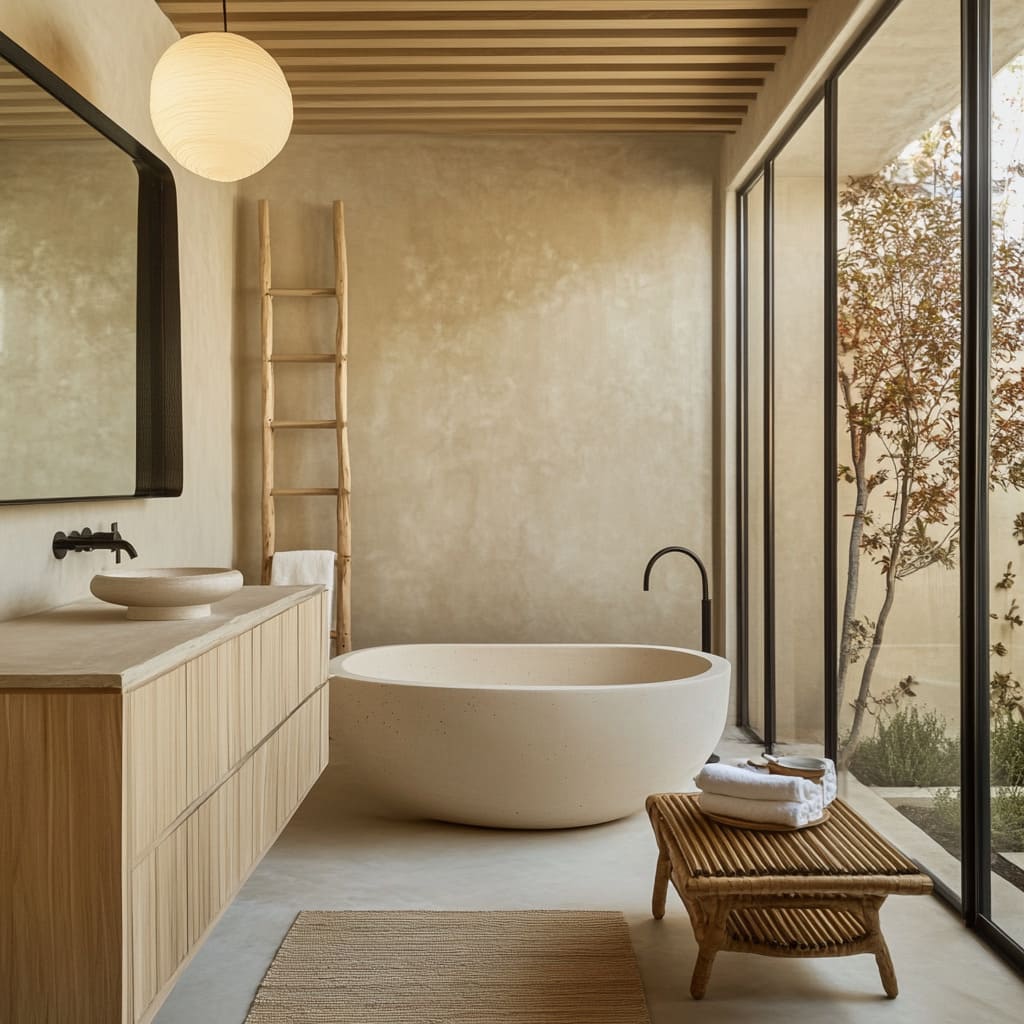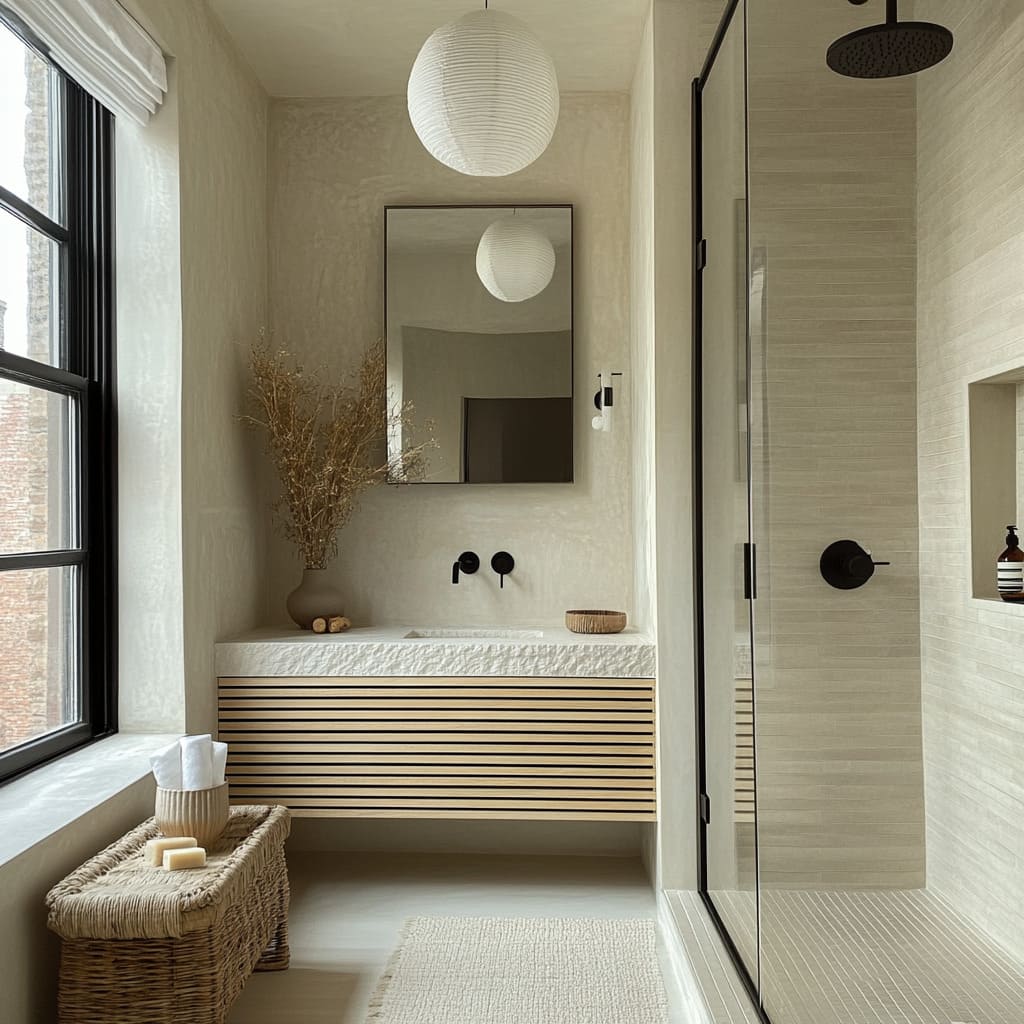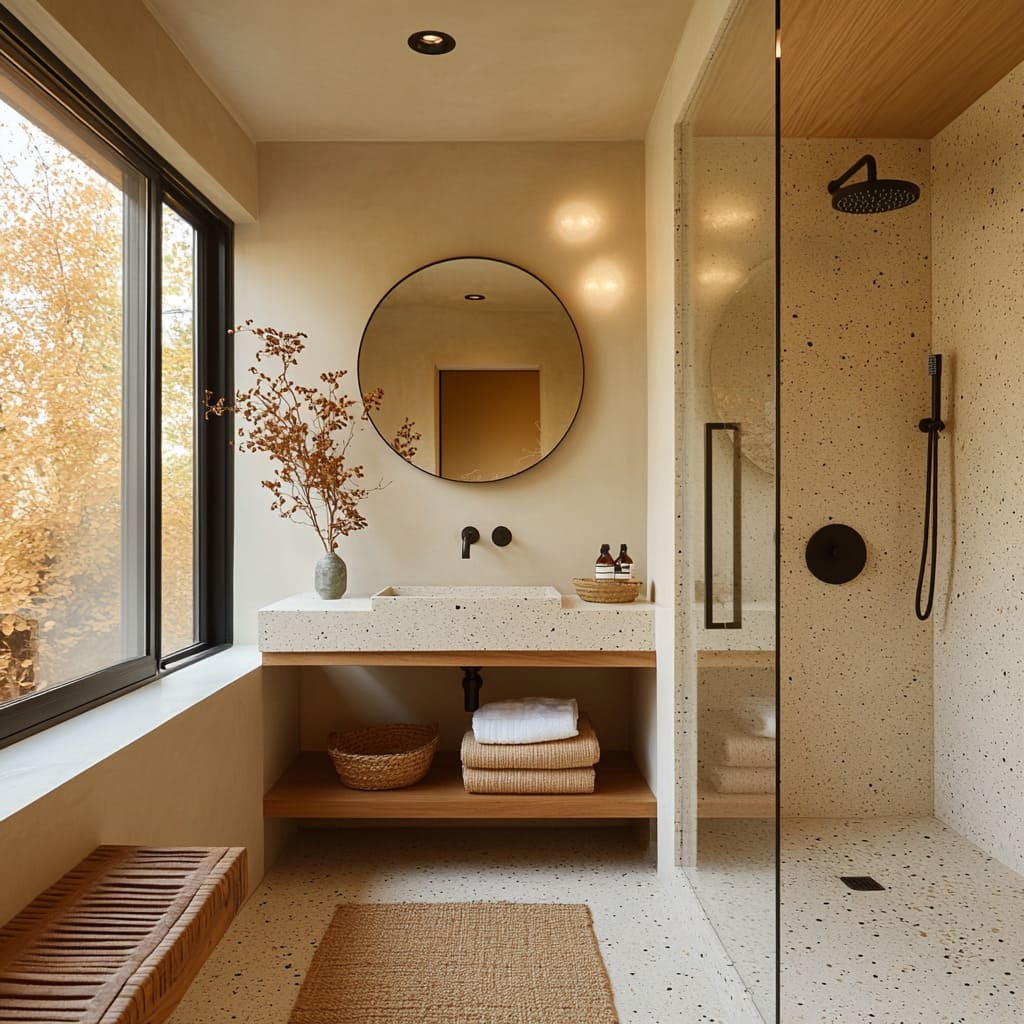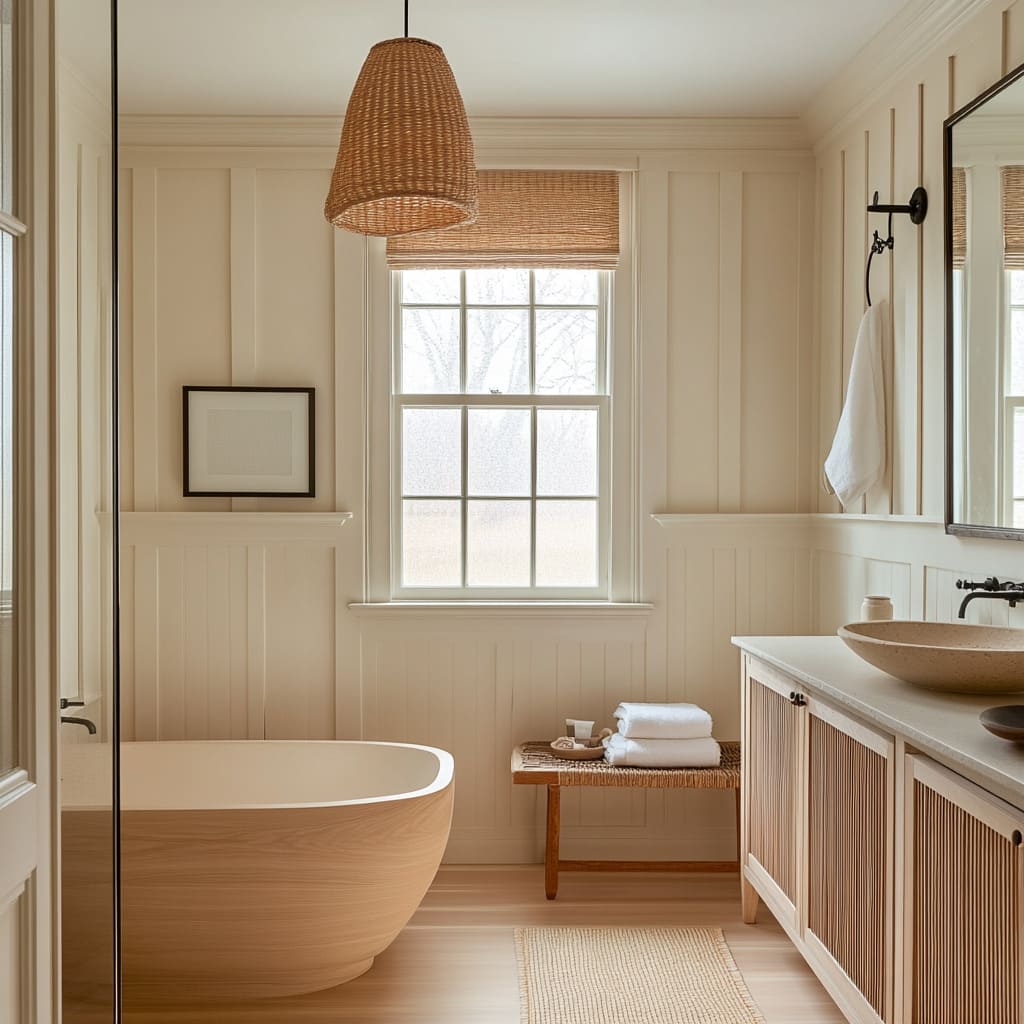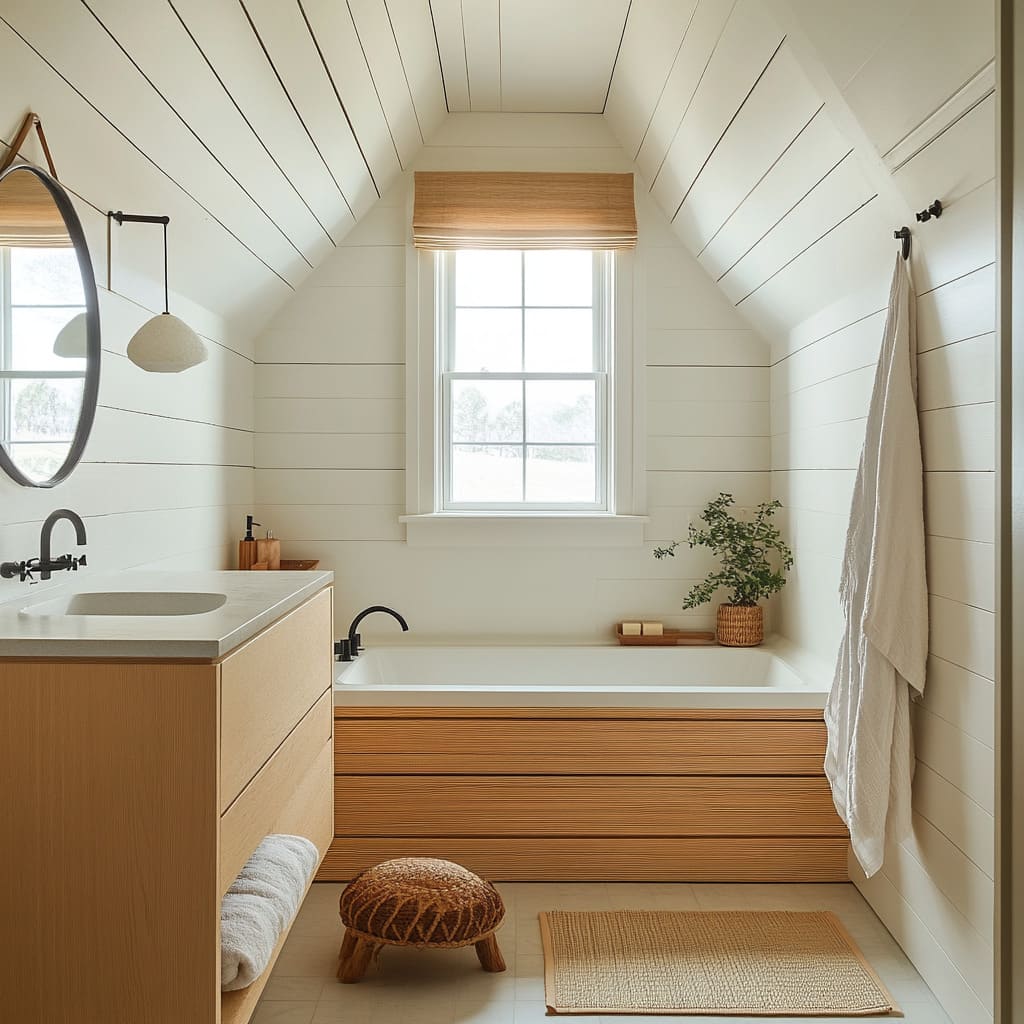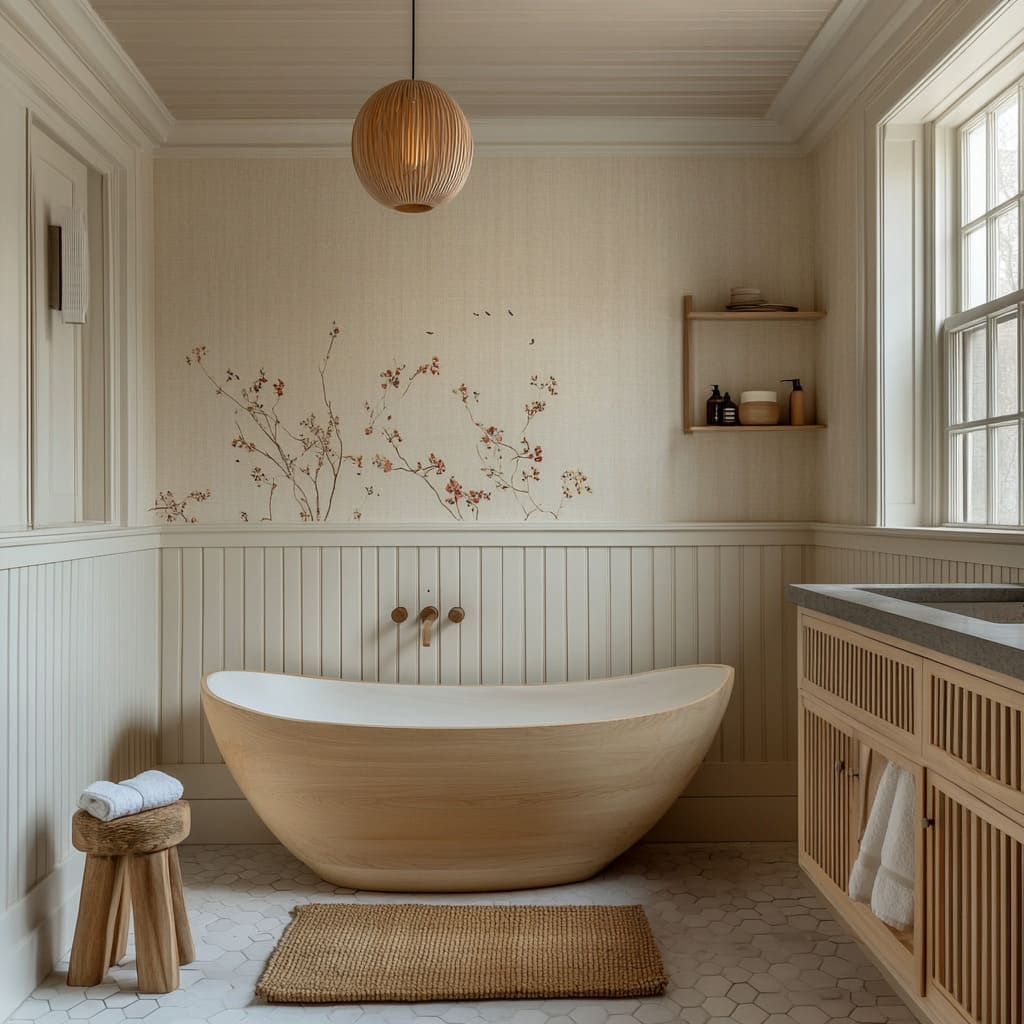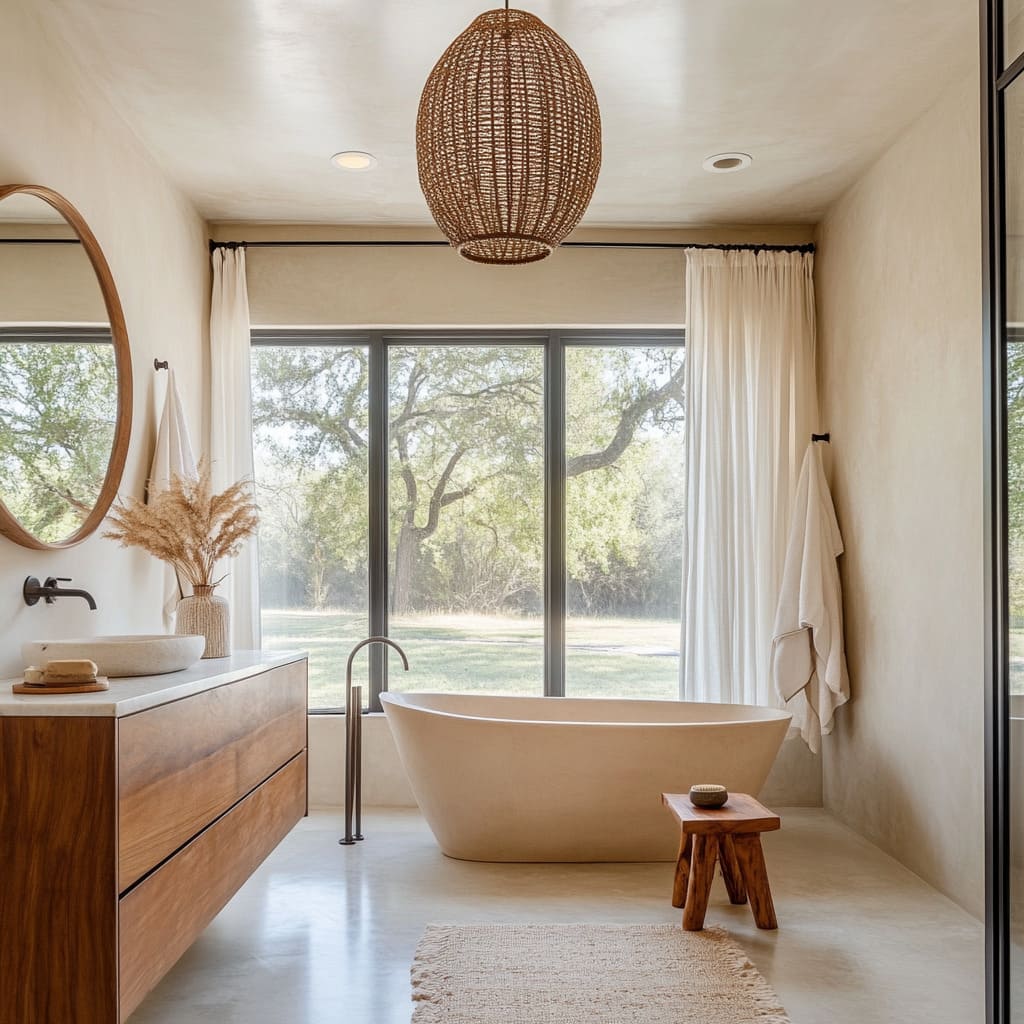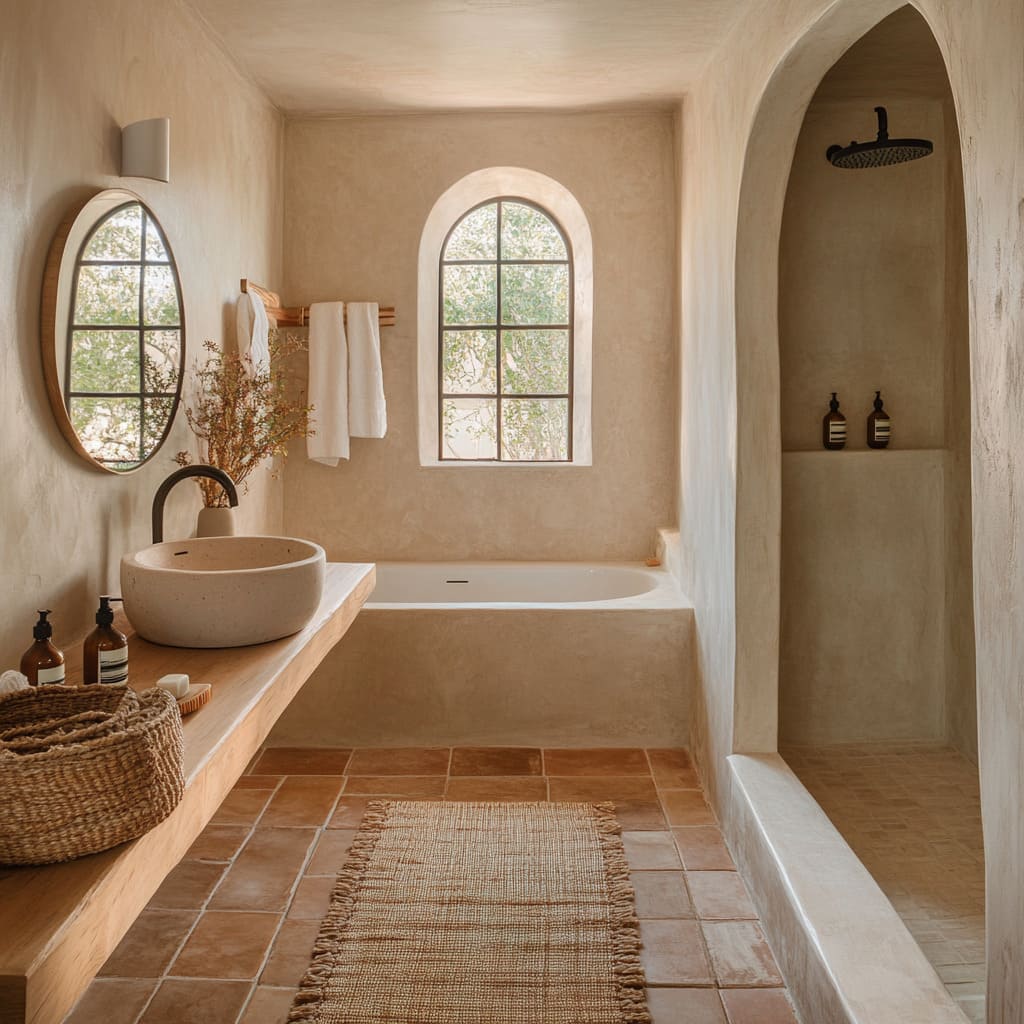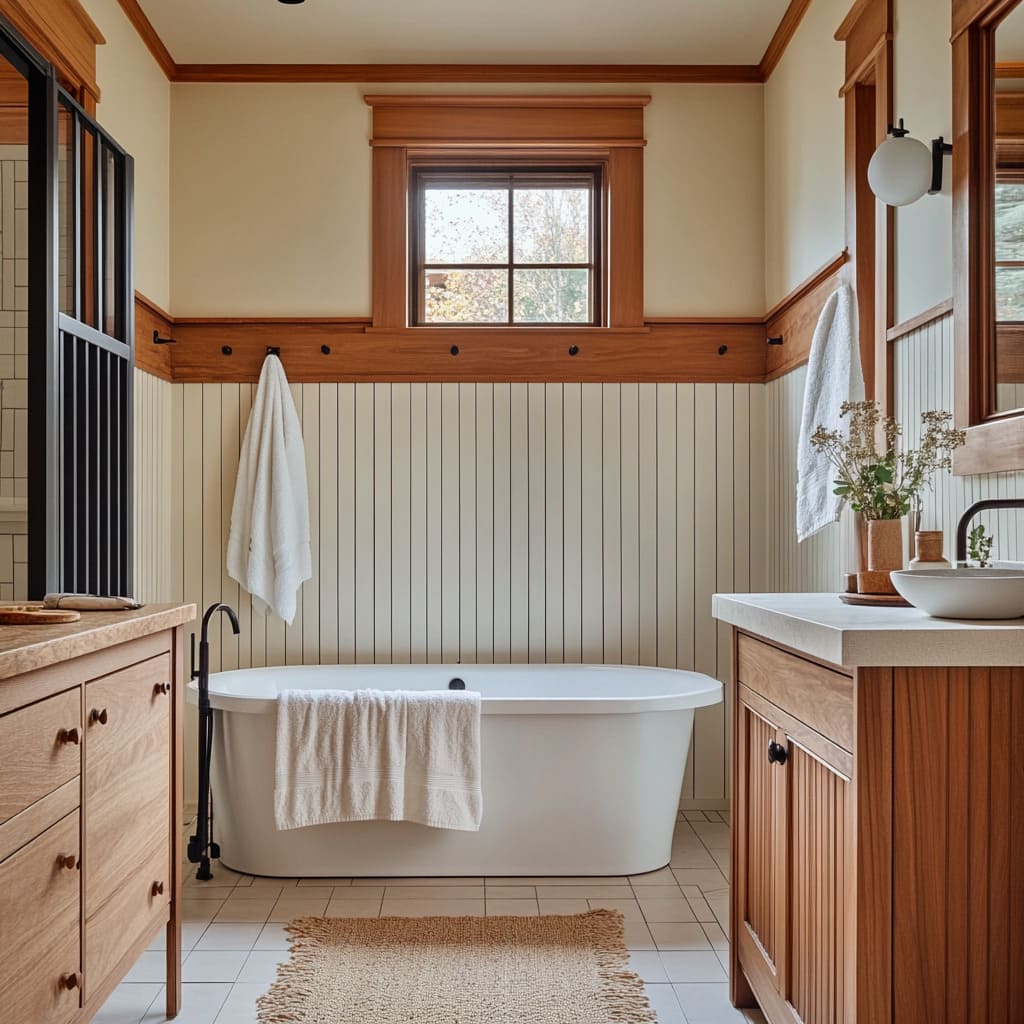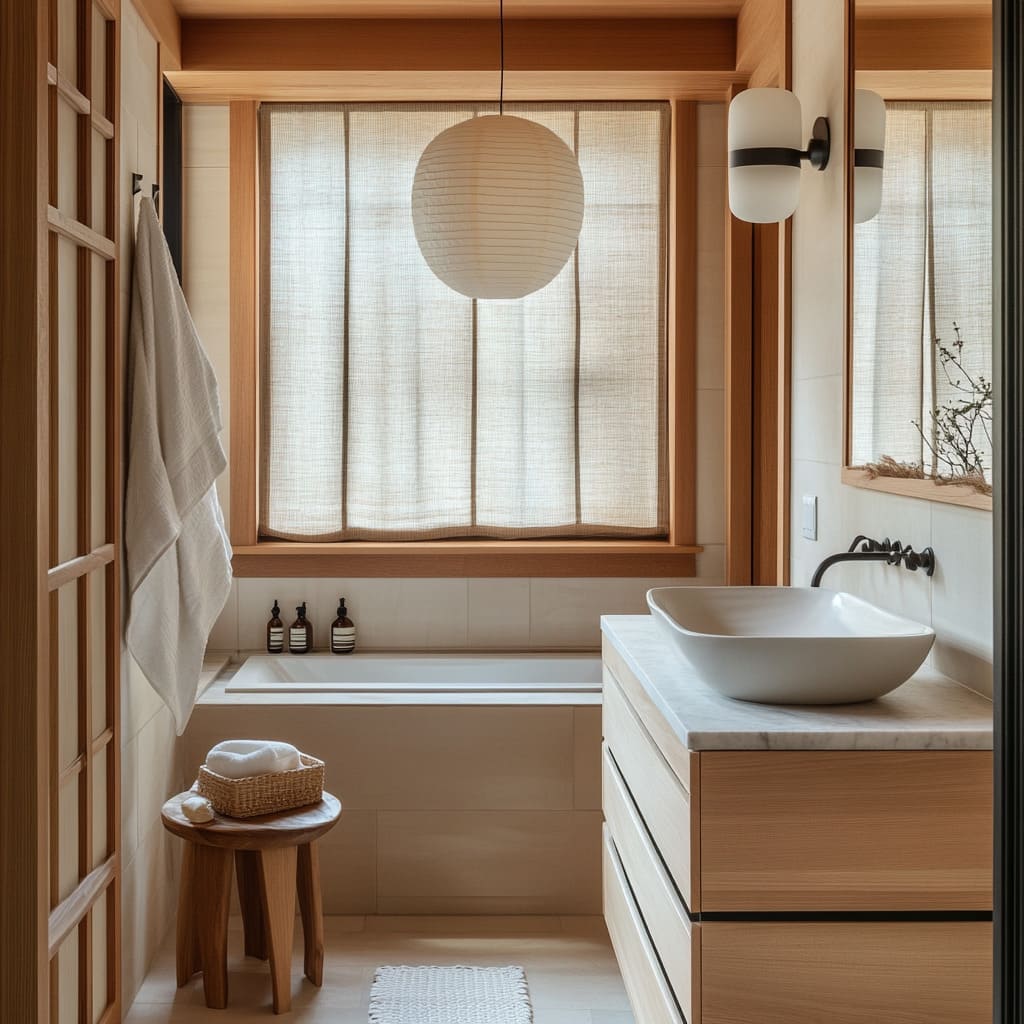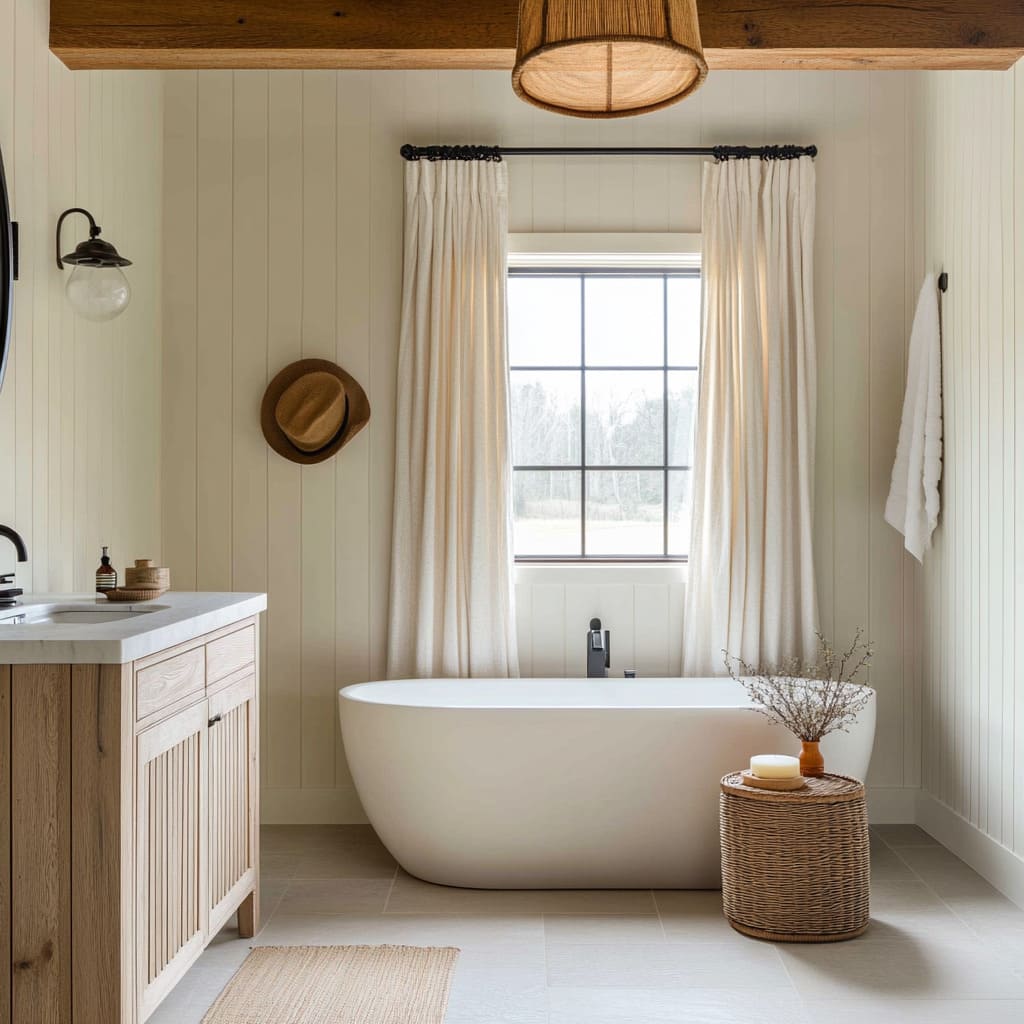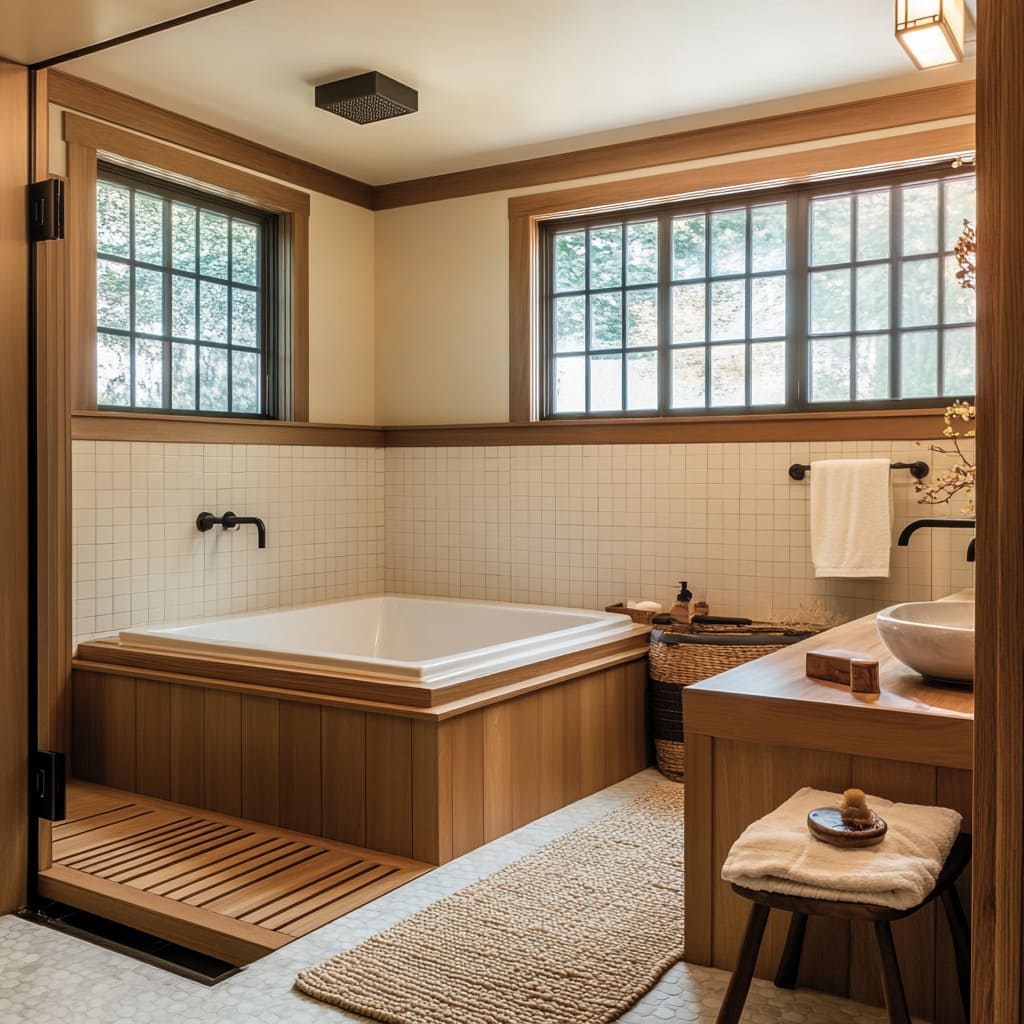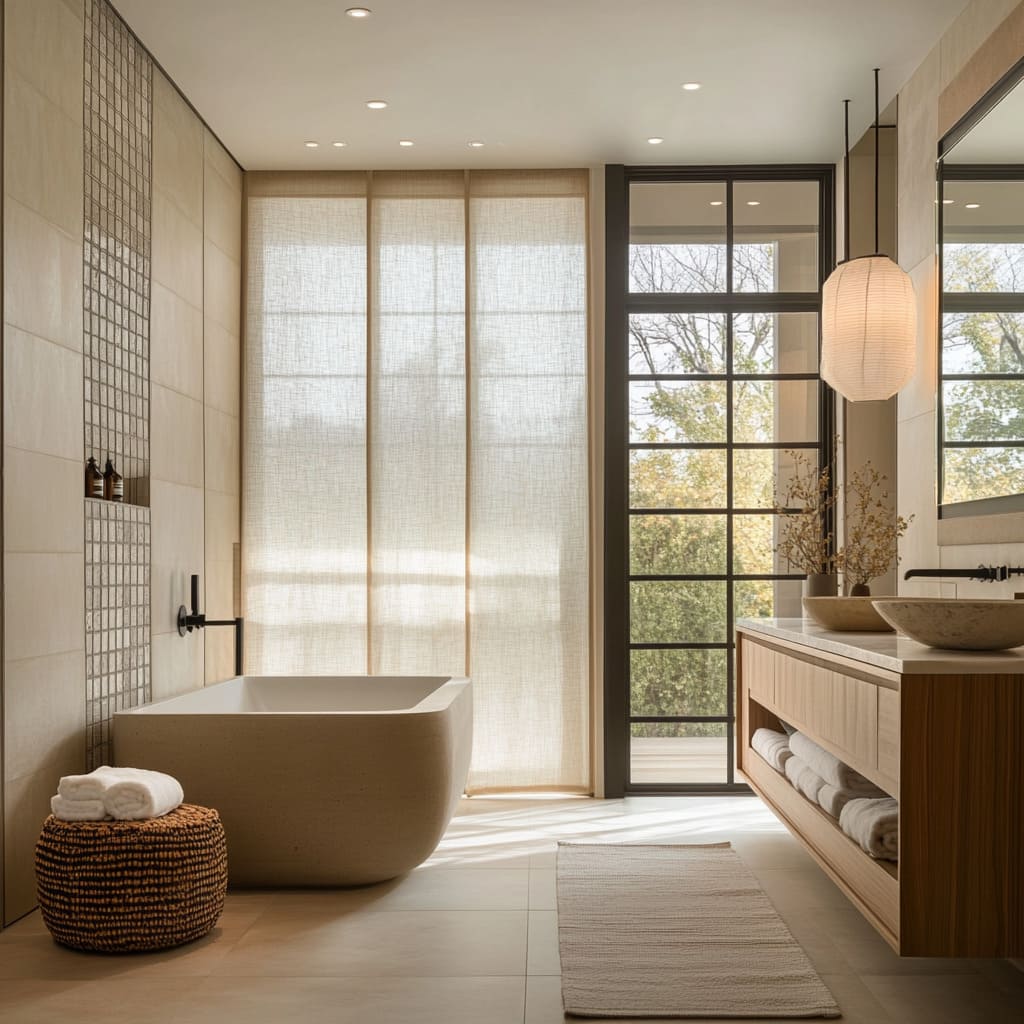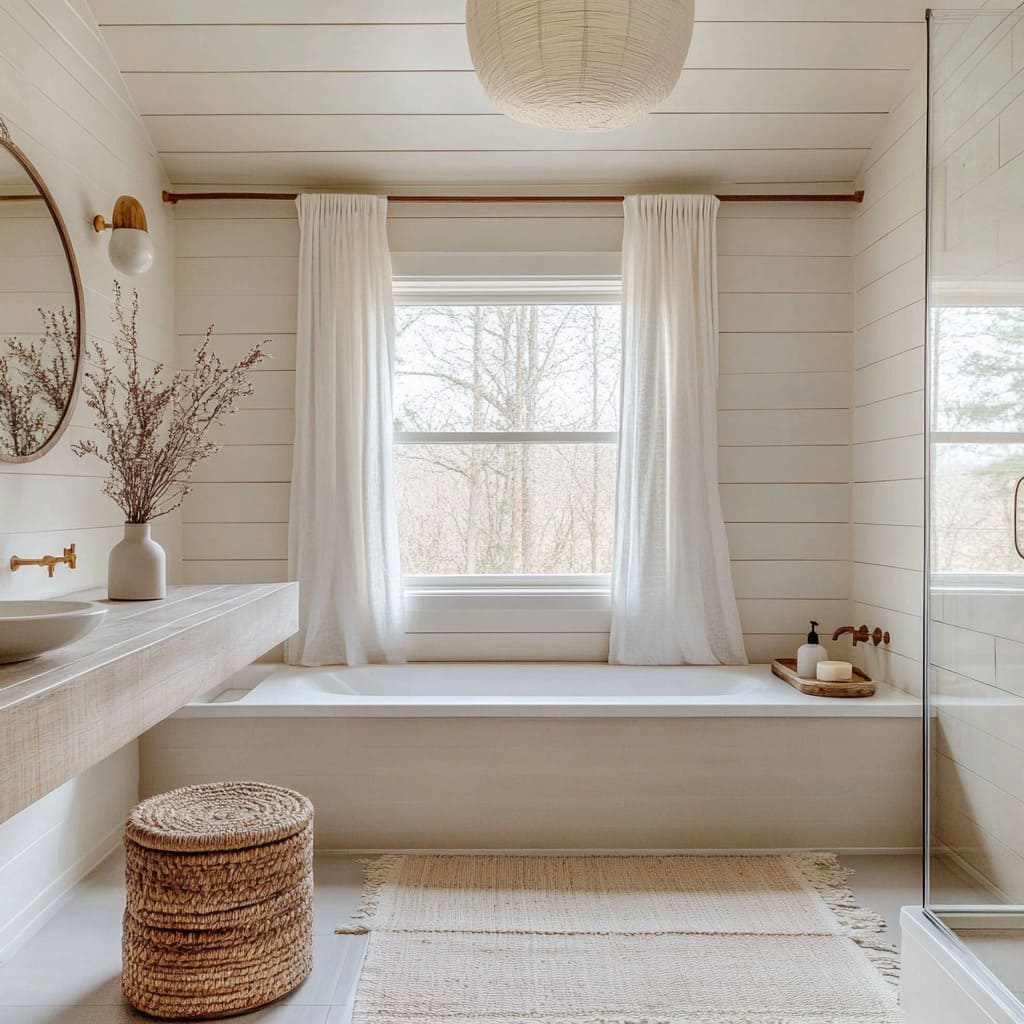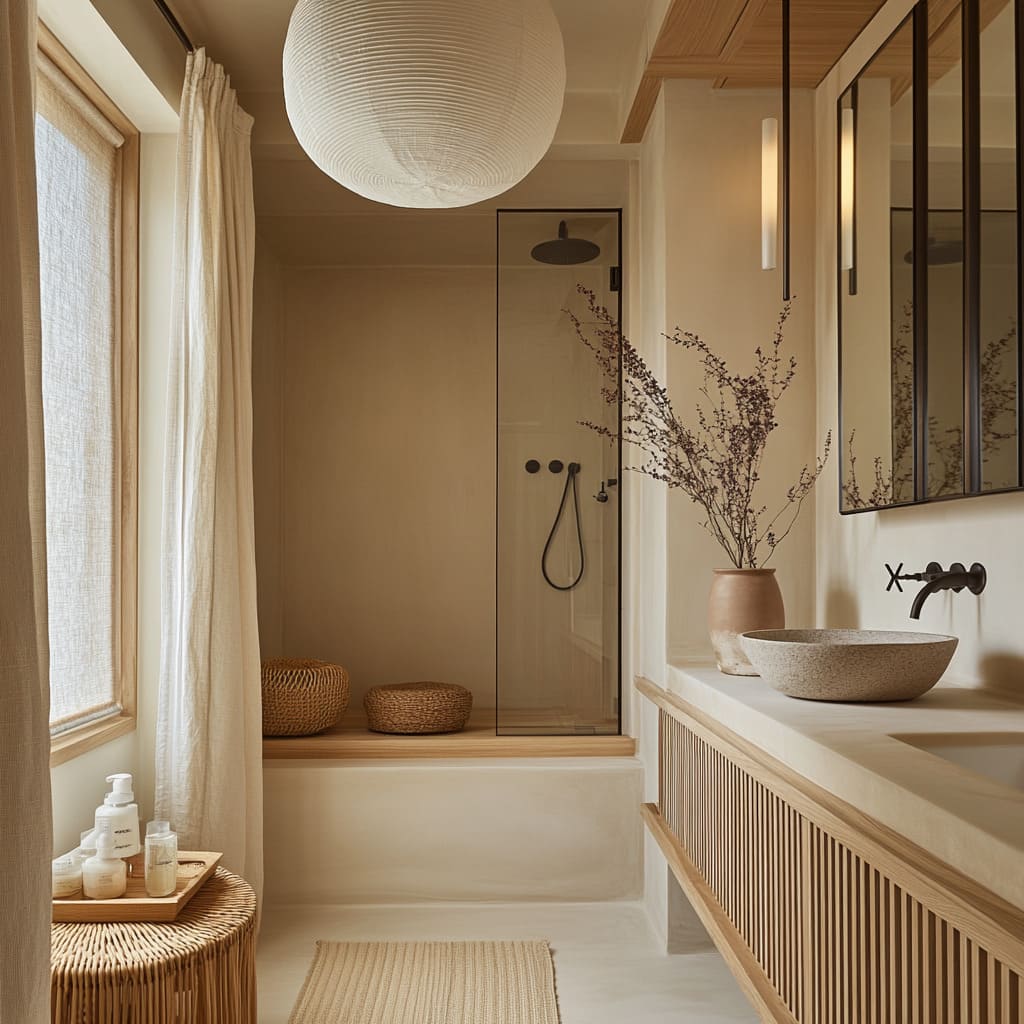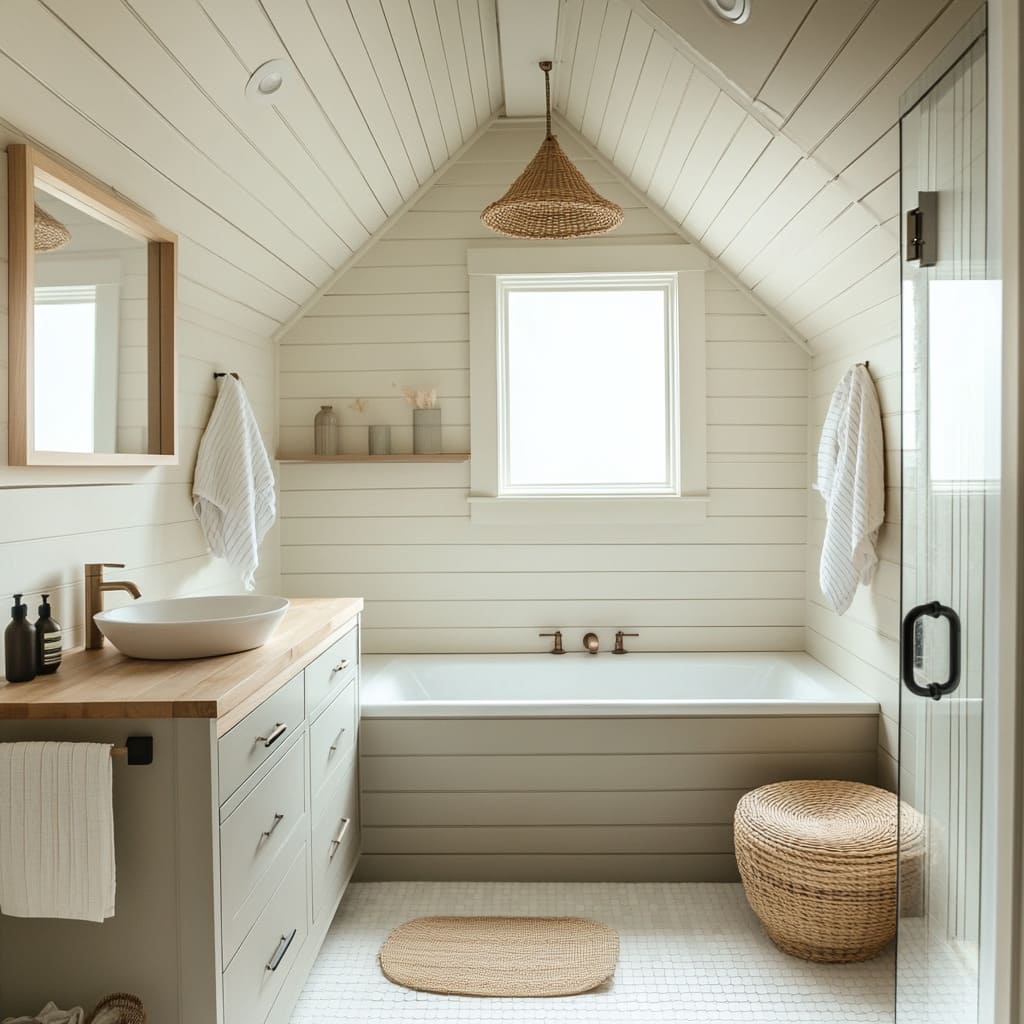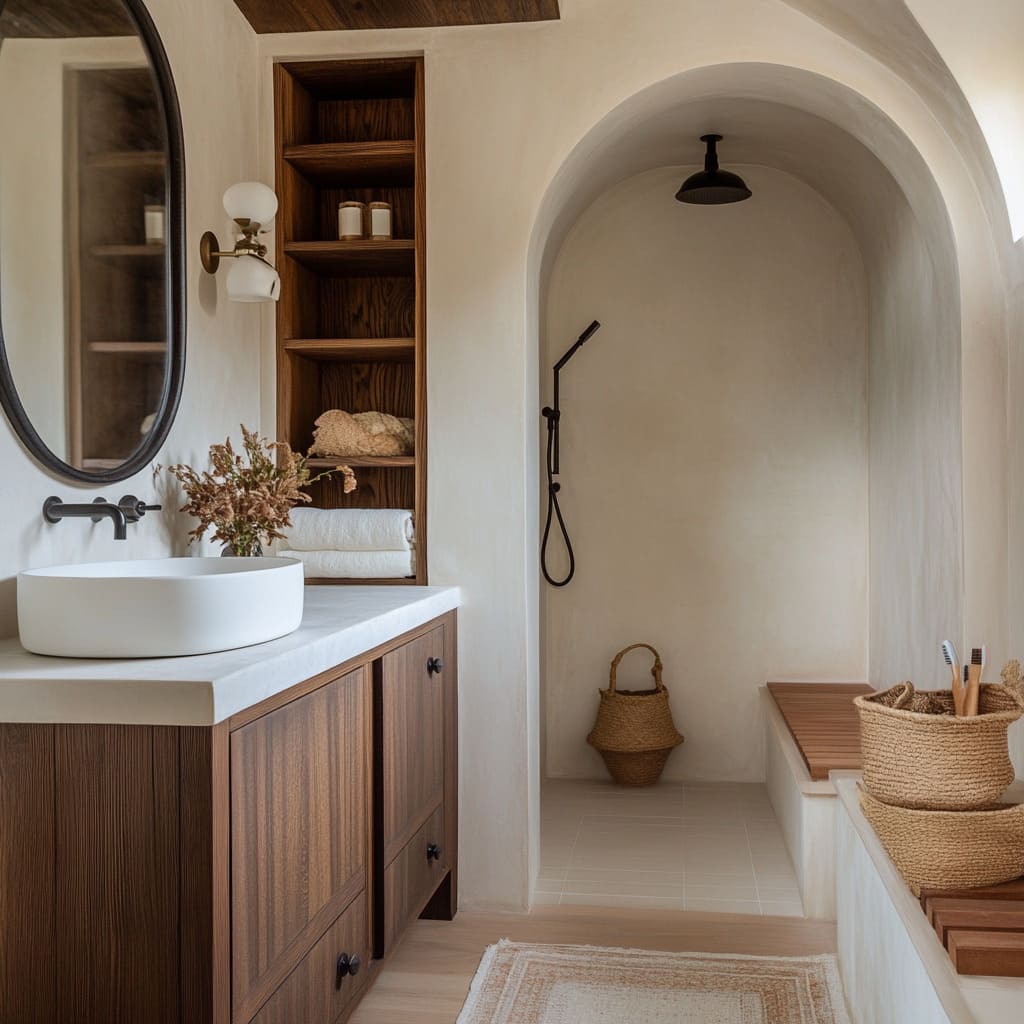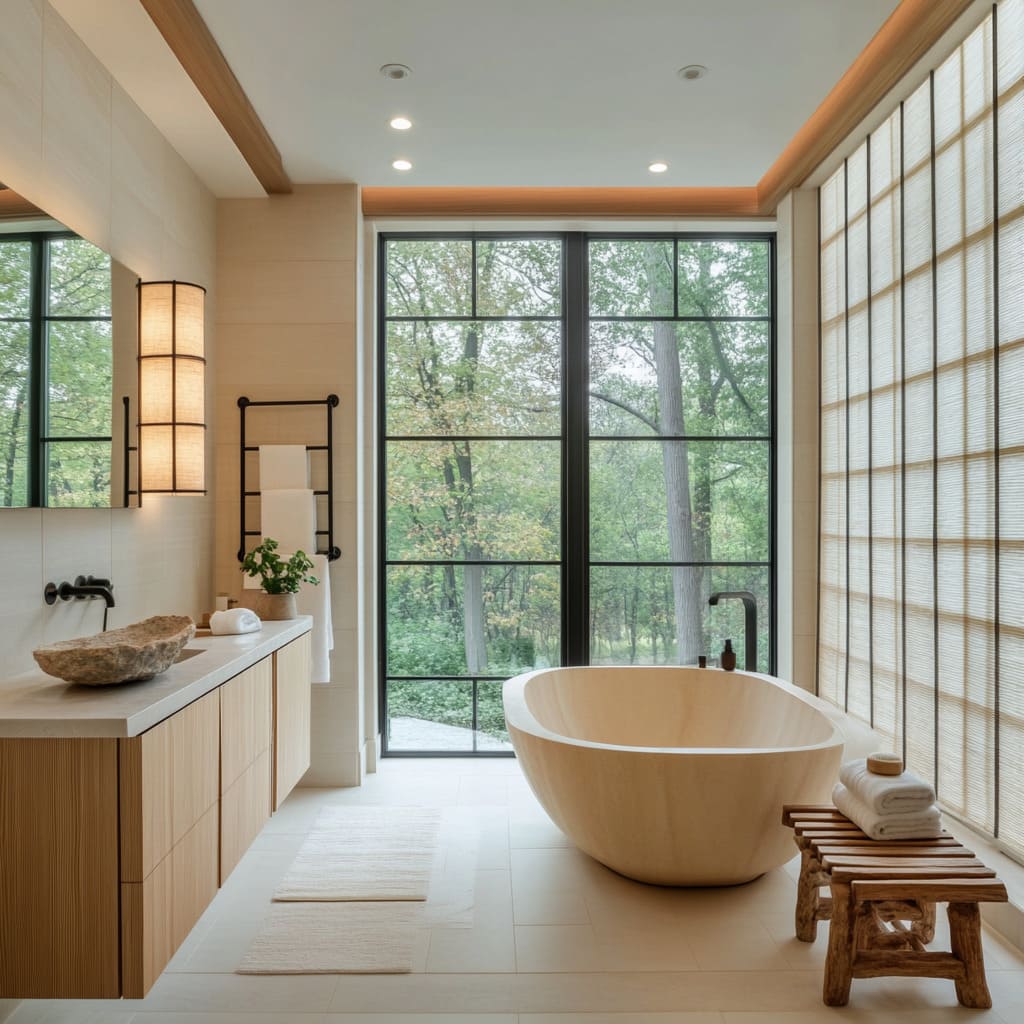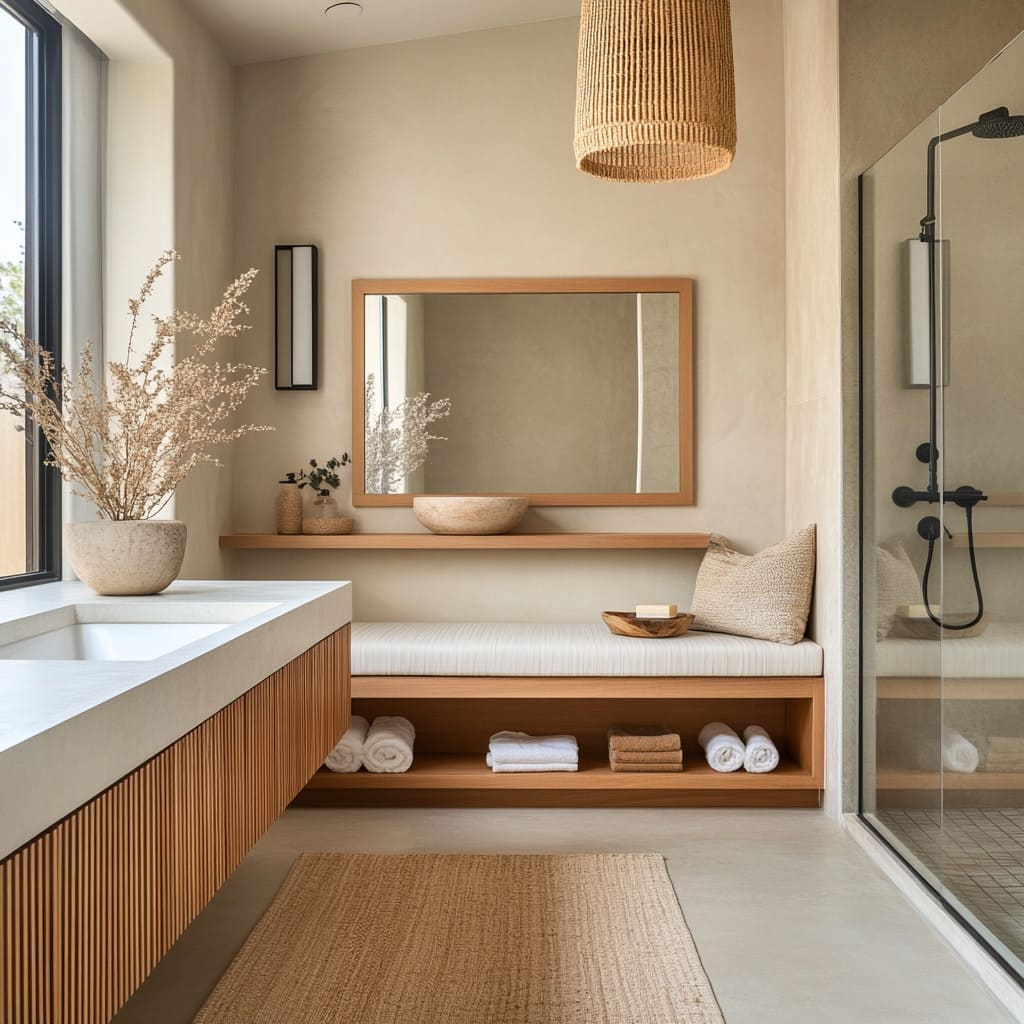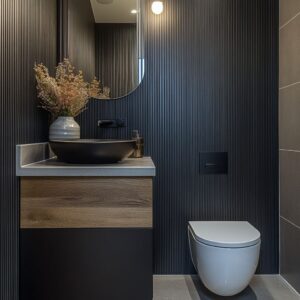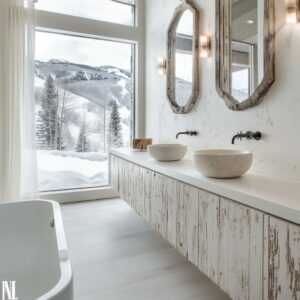The idea of a bathroom as a place to slow down, reset, and unwind has long been part of Japanese culture. Unlike many Western bathrooms that prioritize function above all else, Japanese-style bathrooms are designed with relaxation in mind, embracing natural materials, soft lighting, and a sense of openness.
The result is a space that feels calm, balanced, and deeply connected to its surroundings. Blending this approach with American architecture opens up endless design possibilities.
Whether it’s a Colonial home with classic wainscoting, a Craftsman-style space with exposed wood, or a modern setting with clean lines, Japanese influences can be woven in seamlessly. From freestanding soaking tubs to slatted wooden vanities and paper-like pendant lighting, small details can completely transform a bathroom into a retreat that feels timeless.
In this guide, we’ll explore how to bring these elements into an American home, offering ideas that balance functionality with a peaceful, organic aesthetic. Whether you’re planning a full remodel or just looking for subtle ways to introduce Japanese-inspired elements, these insights will help create a bathroom that feels intentional, welcoming, and effortlessly soothing.
Viewing the Bathtub as a Ritual Center
A bathtub in Japanese bathroom design is more than a fixture—it’s a retreat, a space meant for unwinding and reflection. Unlike many American bathrooms, where tubs are often treated as an afterthought or a purely functional element, Japanese-inspired spaces put the tub at the heart of the experience.
This approach shifts the focus from quick, practical use to an intentional moment of relaxation, inspired by the centuries-old tradition of deep soaking baths.
How to Make It Work
Positioning for Relaxation
To truly embrace this idea, placement is key. If space allows, position the bathtub where it has a direct view of a natural element—whether that’s a window overlooking a small garden, an outdoor rock arrangement, or even a well-placed indoor plant setup.
The goal is to create a setting that encourages mental stillness. If an exterior view isn’t possible, adding an indoor feature like a vertical plant wall or textured stone backdrop can achieve a similar calming effect.
A Subtle Architectural Shift
One of the details often seen in traditional Japanese baths is the sense of gentle elevation. Instead of placing the tub directly on the floor, consider incorporating a small platform or built-in step.
This not only provides a slight separation from the rest of the space but also subtly reinforces the idea that stepping into the tub is stepping into a moment of relaxation. Even in a modern American home, a slightly raised tub design can introduce a quiet sense of intention to the bathing experience.
By treating the bathtub as a central feature rather than an afterthought, a bathroom becomes more than just a practical space—it transforms into a personal retreat that encourages slow, mindful living.
Blending Classic American Details with Japanese Minimalism
A well-designed Japandi bathroom doesn’t require stripping a home of its original character. Instead, it’s about balancing the warmth of classic American architecture with the simplicity and intentionality of Japanese design.
The contrast between structured elements like beadboard paneling or exposed beams and the clean, uncluttered aesthetic of Japanese interiors creates a space that feels both familiar and refreshingly understated.
How to Bring These Styles Together
Refining Wall Paneling
Traditional American bathrooms often feature beadboard, wainscoting, or shiplap, which add structure but can sometimes feel overly detailed. Rather than removing these elements, a simple shift in color can bring them in line with a more soothing aesthetic.
Choosing muted, natural shades—soft creams, light grays, or warm taupe—echoes the tones found in Japanese interiors, where color palettes are inspired by tatami mats, rice paper screens, and natural clay walls. This keeps the charm of the original architecture while creating a calming, cohesive atmosphere.
Highlighting Wooden Beams
Many older American homes, especially farmhouses and Craftsman-style builds, have exposed wooden beams that can complement a Japanese-inspired space beautifully. Instead of painting over them, refinishing the wood in a lighter, more natural tone allows it to feel connected to the space rather than overpowering it.
In Japanese homes, visible wooden beams are often left unadorned to showcase the grain and imperfections, embracing a sense of authenticity. Applying this principle in an American setting not only respects the home’s existing structure but also aligns with the idea that materials should be celebrated rather than hidden.
By thoughtfully blending these styles, a Japandi-inspired space can honor both American craftsmanship and Japanese minimalism, creating a bathroom that feels rooted in tradition yet effortlessly tranquil.
Soft Partitions and Light-Diffusing Elements
A well-balanced bathroom layout isn’t just about fixtures and materials—it’s also about how space is defined. Traditional Japanese interiors use partial partitions to maintain openness while subtly separating different areas.
This concept works beautifully in a modern bathroom, where soft, layered divisions can improve both function and ambiance. Instead of solid walls or heavy doors, lightweight screens, sheer fabrics, and frosted panels can bring structure without blocking light or making the space feel enclosed.
How to Introduce Soft Partitions
Sliding Panels with a Shoji-Inspired Look
A full door isn’t always necessary, especially in an ensuite or smaller bathroom. A sliding partition with frosted glass or fabric inserts can create privacy without cutting off the flow of light.
This approach is especially useful for bathrooms that open into a bedroom, helping define the space while keeping it visually connected.
Lighter Textiles for a Softer Effect
Thick curtains or solid shower doors can feel heavy, making a space seem smaller than it is. Swapping them out for sheer linen drapes or soft cotton panels allows light to filter through naturally.
This idea is rooted in Japanese bathroom ideas that favor noren (fabric dividers) over rigid enclosures, helping soften the transition between different areas of the room. These subtle design choices bring a sense of openness, making a bathroom feel brighter, more breathable, and thoughtfully arranged without sacrificing privacy.
Texture, Imperfection, and Wabi-Sabi Thinking
A perfectly polished, factory-made look isn’t the goal in a Japanese-style bathroom renovation—instead, it’s about embracing the beauty of natural textures, subtle imperfections, and the quiet charm of handcrafted materials. The wabi-sabi philosophy values the character that comes with time, use, and organic materials, making the space feel more personal and deeply connected to nature.
How to Bring Texture and Wabi-Sabi Into Your Bathroom
Raw and Natural Surfaces
Instead of sleek, high-gloss finishes, choose materials that show depth and history. A handcrafted stone sink, a lightly textured plaster wall, or unglazed ceramic tiles will introduce warmth and an organic feel.
Japanese interiors often feature surfaces that feel soft to the eye but rich in texture up close—like natural limestone, weathered wood, or hand-formed clay tiles.
Layering with Textiles
Bringing in woven elements—like a seagrass bath mat, linen hand towels, or a rattan stool—adds quiet contrast and makes the space feel more inviting. The slight irregularities in these materials, whether it’s the uneven weave of a basket or the natural grain of wood, create depth and character that mass-produced materials lack.
By incorporating these details, the bathroom becomes a place that feels relaxed, lived-in, and intentionally imperfect—qualities that make it truly timeless.
Incorporating Natural Wood in Functional Elements
Wood plays a central role in Japanese bath design, bringing warmth and a sense of connection to nature. Traditional Japanese baths often feature hinoki or cedar soaking tubs, wooden stools, and slatted flooring, all chosen for their ability to enhance the bathing experience while keeping the space functional.
In a modern Japandi bathroom design, these elements are blended with Scandinavian influences, creating a balance between natural beauty and everyday practicality.
How to Introduce Wood into Your Bathroom
Floating Slatted Vanities and Benches
A floating vanity with wooden slats not only adds texture but also references the thoughtful craftsmanship found in Japanese bathhouses. Slatted designs allow for airflow and visual lightness, preventing a heavy, bulky look.
A wooden bench near the tub serves a dual purpose—offering a place to sit or hold bath essentials while reinforcing a spa-like atmosphere.
Alternative Wood Tub Ideas
While authentic Japanese soaking tubs made from hinoki wood are a luxury, they require meticulous care and can be difficult to source outside Japan. For a similar aesthetic, consider wood paneling around a standard acrylic or stone tub.
This brings in the warmth of natural materials while being more practical for long-term maintenance. A simple wood surround can completely change the feel of the space, adding depth and a natural softness that balances out sleek surfaces.
By incorporating wood in functional yet thoughtful ways, the bathroom becomes more inviting, offering a space that feels grounded, warm, and effortlessly calming.
Innovative Storage That Emphasizes Clean Surfaces
A clutter-free space isn’t just about aesthetics—it’s about creating a bathroom that feels calm and intentional. A Japanese theme bathroom prioritizes streamlined storage, where every item has a purpose and a designated place.
Unlike the typical American approach of filling countertops with toiletries, this design philosophy favors built-in solutions and selective displays, making the room feel more spacious and visually balanced.
How to Design a Clean and Functional Storage System
Recessed Niches and Built-In Storage
Instead of bulky cabinets that take up valuable space, built-in shelving and recessed wall niches provide hidden storage without disrupting the room’s openness. A niche inside the shower can neatly house soaps and shampoos, while a recessed shelf above the vanity keeps daily essentials within reach without overwhelming the countertop.
Wooden sliding doors or panel-covered shelves help maintain an uncluttered look, allowing storage to blend seamlessly with the overall design.
Minimalist Open Displays
If open shelving is preferred, the key is restraint. A few carefully arranged items—such as a small stack of linen towels, a handcrafted ceramic jar, or a simple wooden tray—can add warmth while keeping the space organized.
By reducing the number of visible objects, the bathroom takes on a curated feel, reinforcing the sense of tranquility that defines Japanese and Japandi interiors. By shifting from traditional cabinet-heavy storage to more subtle and integrated solutions, a bathroom can feel effortlessly clean while remaining practical for daily use.
Illumination That Feels Soft, Layered, and Calm
Lighting in a bathroom does more than just provide visibility—it shapes the entire atmosphere. Instead of harsh overhead fixtures that create a stark, clinical effect, a well-balanced lighting setup introduces softness and warmth.
In Japandi bathroom ideas, lighting follows a layered approach, using gentle, diffused illumination that enhances relaxation. Inspired by traditional Japanese interiors, this method creates a glow that feels natural and inviting rather than overwhelming.
How to Create a Relaxed Lighting Scheme
Paper-Inspired Fixtures for a Gentle Glow
One of the most effective ways to introduce soft lighting is through pendant lamps or sconces with fabric or paper-like shades. These diffuse light rather than projecting it harshly, mimicking the effect of traditional washi paper lanterns found in Japanese interiors.
Whether in the form of a sculptural hanging light or a wall-mounted fixture, this type of illumination adds warmth without overpowering the space.
Layered Lighting for Depth and Functionality
A well-designed bathroom needs more than just one central light source. Combining ambient lighting with lower-level illumination creates flexibility—brighter when needed, but easily dimmable for a more peaceful atmosphere.
Wall sconces near the vanity, a subtle LED strip beneath a floating vanity, or a soft glow near the bathtub all work together to make the space feel balanced. Keeping the light warm-toned rather than cool prevents the bathroom from feeling too stark, enhancing its calming effect.
By choosing lighting that diffuses rather than dominates, a bathroom can feel like a retreat, with layers of soft illumination that complement the surrounding textures and materials.
Merging Existing American Styles with Japanese Themes
Blending Japanese influences into an American home isn’t about replacing what’s already there—it’s about creating harmony between existing architectural elements and a refined, natural aesthetic. Whether it’s a Cape Cod home with vaulted ceilings, a Tudor-style house with soft archways, or a Craftsman build featuring exposed beams and built-in cabinetry, Japanese design principles can be woven in seamlessly.
The key is to enhance, not compete, allowing both styles to coexist in a way that feels natural and intentional.
How to Create a Balanced Fusion
Work with Your Home’s Original Features
Instead of stripping away defining architectural elements, refine them with subtle details that align with Japanese design sensibilities. For instance, if your home has a classic Tudor arch, smoothing out the edges with plaster or adding understated wood trim can echo the gentle, curved forms seen in traditional Japanese inns.
Similarly, exposed wooden beams in a Craftsman-style house can be left visible and finished in a lighter, natural stain to complement a minimalist aesthetic.
Use Color to Unify the Space
Matching a home’s existing materials with earthy, neutral tones helps create cohesion between American and Japanese influences. A Spanish Revival home, for example, might already have warm beige or terracotta tiles—pairing these with simple Japanese-inspired lighting, textured plaster walls, and wooden details can bridge the gap between both styles effortlessly.
By taking inspiration from Japanese bathroom design ideas and adapting them to fit within the home’s existing character, the result is a space that feels balanced, inviting, and thoughtfully put together.
Final Thoughts
A well-designed Japanese-inspired master bathroom isn’t about replicating an exact traditional setup—it’s about creating a space that feels natural, calming, and connected to its surroundings. The beauty of this approach is that it works within the framework of an existing home, whether that’s a Colonial house with detailed molding, a Craftsman home with rich woodwork, or a Cape Cod retreat with bright, airy finishes.
Instead of changing everything, focus on a few meaningful elements that bring out the essence of Japanese design. A wooden soaking tub can instantly shift the mood of a space, a soft paper-like pendant light can introduce a warm glow, and a carefully placed built-in niche can bring effortless organization.
These details, when thoughtfully integrated, create a bathroom that feels intentional and timeless, while still being completely in tune with your daily routine. By blending simplicity, natural materials, and quiet elegance, the result is a bathroom that goes beyond trends—one that offers a sense of balance and relaxation every time you step inside.
